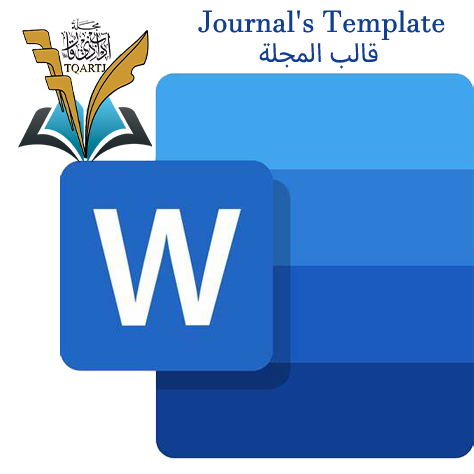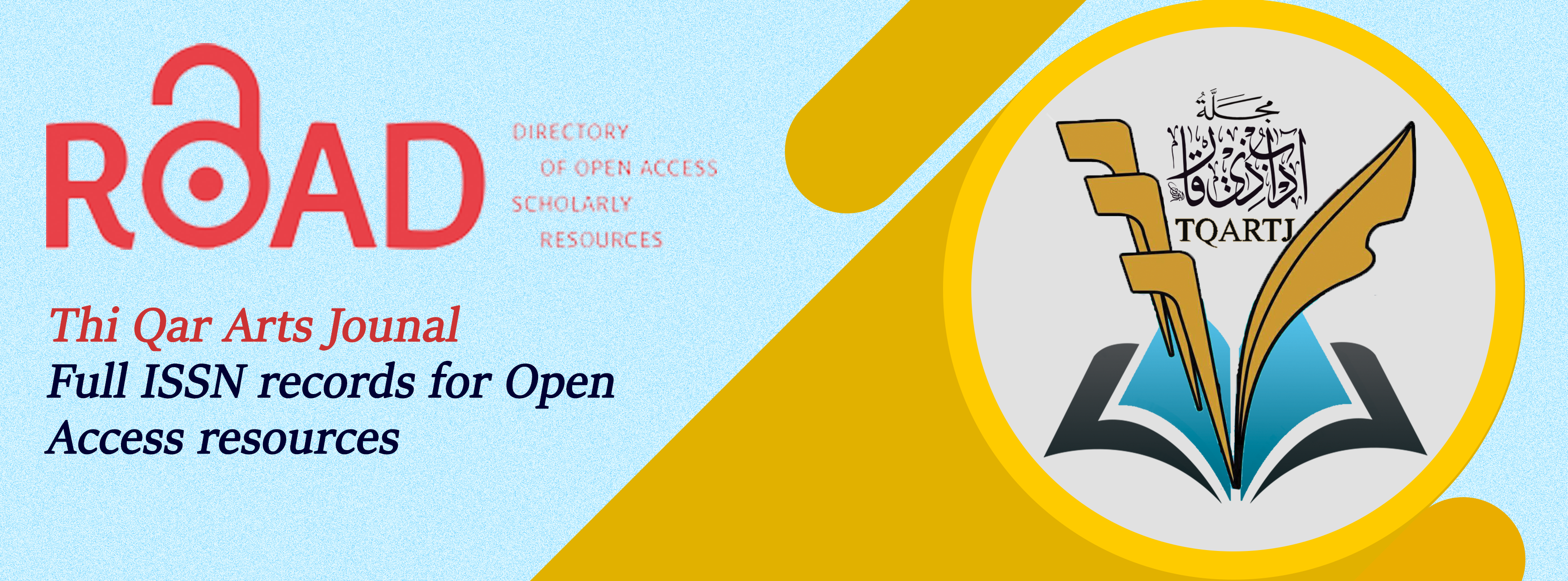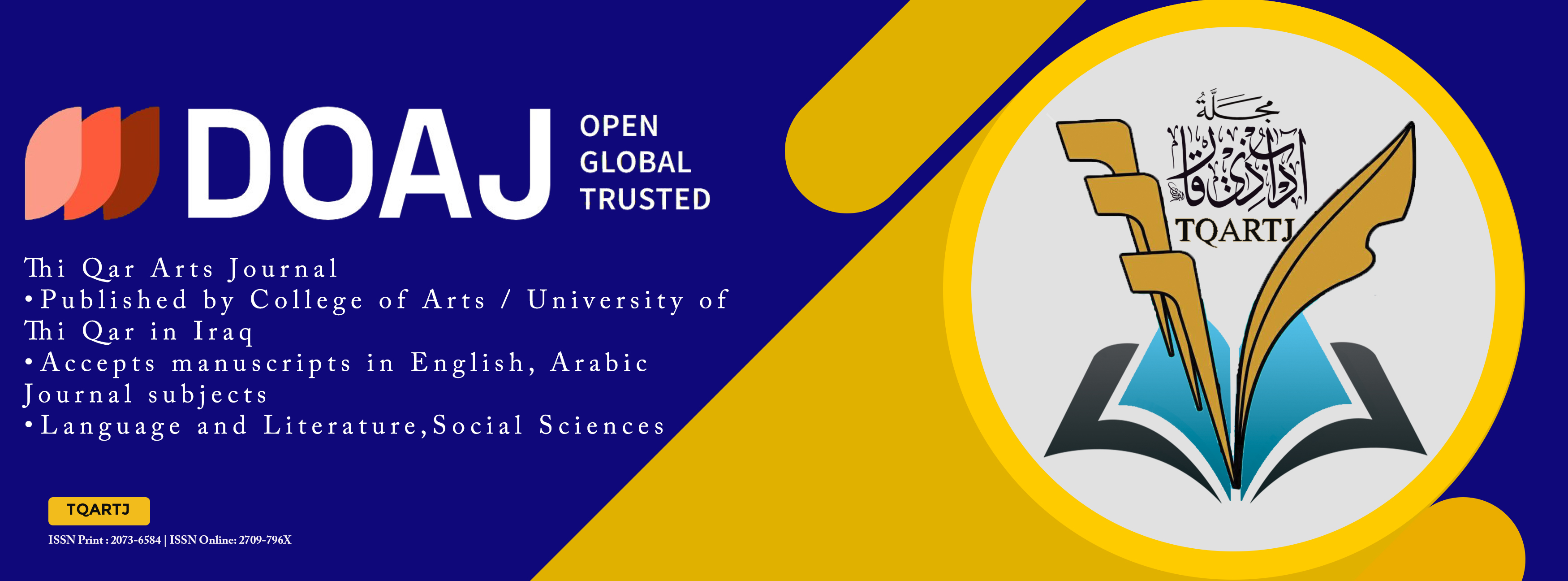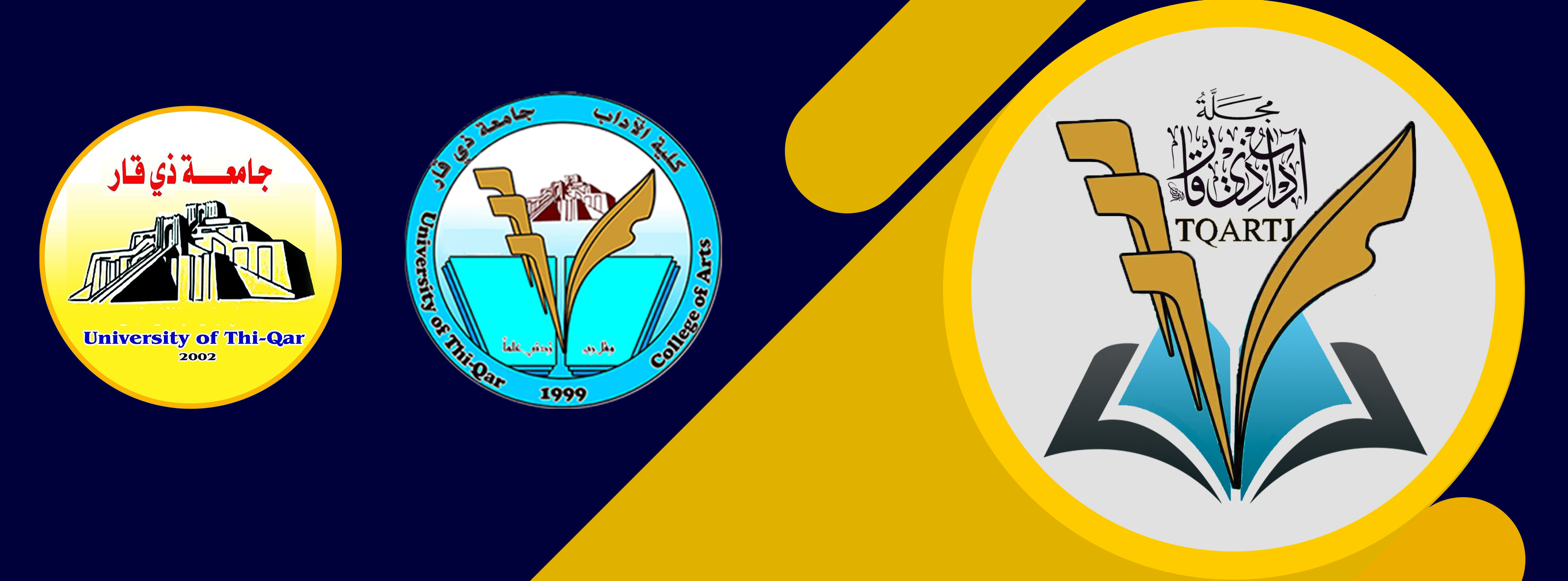Textual reading of issues in Arabic grammar
DOI:
https://doi.org/10.32792/tqartj.v1i43.471Keywords:
textual science, poet’s weaving, vocabulary, cohesion and connection, textual units.Abstract
Textual modernists developed concepts, terminology, and standards for understanding and reading any text, seeking to make texts subject to the concepts, standards, and terminology they established - regardless of the size and nature of the text - but textualists were attracted by the text as a comprehensive structure more than they were attracted by the sentence, so studies on literary texts and their analysis began in In light of what textual science has brought, most studies have dealt with Qur’anic, poetic, and narrative texts. To show the disparity between texts and highlight their impact on the recipient, our research, titled ((Textual reading of issues in Arabic grammar)), also seeks to analyze texts for seven grammatical issues that adopted a well-known opinion or what includes its meaning according to a textual reading, and to demonstrate the ability of these issues to persuade the reader. The learner uses the argument and evidence that the grammarian brought to prove a grammatical rule, by recalling the concepts, tools and standards of textual science.
Therefore, the research methodology required starting with the concept of text in our Arabic language and how text was understood in other languages. Because it is the raw material that the study works to describe and analyze, it becomes clear that the text has a peculiarity represented by its independence, closure, and lack of reference to size, and that it is subject to several controls.
Then we move on to identifying the text analysis tools and the standards adopted by these tools. As for the seven grammatical issues that the study shed light on, they were selected from different time periods and from different grammatical books as well. To show that these standards adopted by the hadith scholars are mostly consistent to a large extent with every text written at a certain time, and that it has an impact on the reader at that time or in our time
Downloads
References
The Holy Quran.
Drinking the strike from the tongue of the Arabs, by Muhammad bin Yusuf, known as Abu Hayyan al-Andalusi, who died in 745 AH, edited by: Rajab Othman Muhammad, reviewed by: Ramadan Abdel Tawab, Al-Khanji Library in Cairo, first edition, 1998 AD.
The origins of Arabic grammar: by Muhammad Khair al-Halwani, Tishreen University, Latakia, Syria, 1979 AD.
The foundations of discourse analysis in Arabic grammatical theory (establishing the grammar of the text): by Muhammad al-Shawash, the Arab Foundation for Distribution, Beirut, first edition, 2001 AD.
The Azhiyya in the science of letters: by Abu al-Hasan Ali bin Muhammad al-Nahwi al-Harawi, who died around 415 AH, edited by: Abdul Muin al-Mallouhi, the Arabic Language Complex in Damascus, second edition, 1981 AD.
The principles of grammar: by Abu Bakr Muhammad bin al-Sari bin Sahl al-Nahwi, known as Ibn al-Siraj, who died in 316 AH, edited by: Abdul Hussein al-Fatli, Al-Risala Foundation, Beirut, third edition, 1988 AD.
The justice in the matters of dispute between the Basra and Kufa grammarians: by Abu al-Barakat al-Anbari, the Modern Library, first edition, 2003 AD.
The hidden treasure in the precious metal of the essence of literature in the science of metaphors of the Arabs: by Abu al-Hajjaj Yusuf bin Sulaiman bin Isa al-Alam al-Shantamari, who died in 476 AH, edited by: Zuhair Abdul Muhsin Sultan, Al-Risala Foundation, Beirut, second edition, 1994 AD.
The Kamel: by Abu al-Abbas al-Mubarrad, who died in 286 AH, presented by his origins and commented on by: Taghreed Baydoun and Naim Zorzour, Dar al-Kutub al-Ilmiyyah, Beirut, first edition, 1987 AD.
The Book: by Abu Bishr Amr bin Uthman bin Qunbar, nicknamed Sibawayh, who died in 180 AH, edited by: Abdul Salam Muhammad Haroun, Al-Khanji Library, Cairo, third edition, 1988 AD.
The Lame in Arabic: by Ibn Jinni, edited by: Faez Fares, Dar al-Kutub al-Thaqafiyyah, Kuwait.
The linguistic introduction in the criticism of poetry, a structural reading: by Mustafa al-Saadi, Munshaat al-Maarif, Alexandria - Egypt, 1967 AD.
The problematic issues (known as the Baghdadis): by Abu Ali al-Farsi, edited by: Yahya Murad, Dar al-Kutub al-Ilmiyyah, 2003 AD.
The meaning outside the text: by Fatima al-Shidi, Dar Ninawa, Damascus, first edition, 2011 AD.
The concise: by Abu al-Abbas al-Mubarrad, edited by: Muhammad Abdel Khaleq Adhima, the world of books, Beirut.
The text and the context, an investigation of the research in the semantic and pragmatic discourse: Van Dijk, translated by: Abdel Qader Qanini, Beirut, East Africa, 2000 AD.
The authority of the text: readings in the employment of the religious text: by Abdel Hadi Abdel Rahman, the Arab Dissemination Foundation, Beirut, 1988 AD.
The construction of the Arabic sentence: by Muhammad Hamasah Abdel Latif, Dar Ghareeb, Cairo, 2003 AD.
The collection of the eye of gold from the mineral of the essence of literature in the science of metaphors of the Arabs: by Abu al-Fadl Ahmad bin Ali bin Muhammad bin Ahmad bin Hajar al-Asqalani, who died in 852 AH, edited by: Muhammad Abdel Moeed Khan, the Ottoman Encyclopedia Council, Hyderabad - India, second edition, 1972 AD.
The secret of the art of parsing: by Ibn Jinni, edited by: Hassan Hindawi, Dar al-Kutub al-Ilmiyyah, Beirut, Lebanon, first edition, 2000 AD.
The explanation of Ibn Aqeel on the thousand of Ibn Malik: by Abdullah bin Abdul Rahman al-Aqeeli al-Hamdani, known as Ibn Aqeel, who died in 769 AH, edited by: Muhammad Mohiuddin Abdul Hamid, Dar al-Turath, Cairo, twentieth edition 1980 AD.
The explanation of Abu Jaafar al-Nahas on the verses of Sibawayh: by Abu Jaafar al-Nahas, edited by: Zuhair Ghazi Zahid, the world of books, Beirut, first edition, 1986 AD.
The explanation of the facilitation: by Muhammad bin Abdullah bin Abdullah, famous as Ibn Malik, who died in 672 AH, edited by: Abdul Rahman al-Sayed, and Muhammad Badawi al-Mukhtoun, Hijra for Printing and Publishing, Egypt, first edition, 1990 AD.
The explanation of al-Razi on al-Kafiyyah: by Radi al-Din Muhammad bin al-Hasan al-Istarabadi, who died in 686 AH, correction and commentary: Yusuf Hassan Omar, Qaryounis University Publications, second edition, 1996 AD.
The explanation of al-Kafiyyah al-Shafiyyah: by Abu Abdullah Muhammad bin Abdullah, famous as Ibn Malik, who died in 672 AH, edited by: Abdul Munim Ahmed Haridi, Umm al-Qura University, Mecca, first edition.
The explanation of al-Mufassal: by Abu al-Baqaa Yaish bin Ali bin Yaish al-Mosuli, who died in 643 AH, introduced by him and put his margins and indexes: Emile Badi Yaqoub, Dar al-Kutub al-Ilmiyyah, Beirut, Lebanon, first edition, 2001 AD.
The evidence of clarification and correction of the problems of the authentic collection: by Jamal al-Din bin Malik al-Andalusi, who died in 672 AH, edited by: Taha Mohsen, Ibn Taymiyyah Library, 1413 AH.
Sahih al-Bukhari, Dar Ihya al-Kutub al-Arabiyyah, Cairo.
General linguistics: by Ferdinand de Saussure, translated by: Joel Youssef Aziz, Dar Afak Arabiya, Baghdad, third edition, 1985 AD.
The science of the text language between theory and application (an applied study on the Meccan surahs): by Ibrahim Subhi al-Faqi, Dar Quba for Printing and Publishing, Cairo, first edition, 2000 AD.
The science of the text language, concepts and trends: by Said Hassan Bahiri, the Egyptian International Company for Publishing - Longman, Cairo, first edition, 1997 AD.
The science of the text language and style between theory and application: by Nadia Ramadan al-Najjar, Horus International Foundation for Publishing and Distribution, Alexandria - Egypt, 2013 AD.
Lisan al-Arab: by Abu al-Fadl Jamal al-Din Muhammad bin Makram bin Ali Ibn Manzur, who died in 711 AH, Dar Sader, Beirut, third edition, 1414 AH.
Text linguistics, a theoretical and applied approach (Hamadhani’s maqamat as a model): by Linda Qiyas, Al-Adab Library, Cairo, first edition, 2009 AD.
Text linguistics, an introduction to the harmony of discourse: by Muhammad Khatabi, the Arab Cultural Center, Beirut, second edition, 2006 AD.
An introduction to the science of text language: by Ilham Abu Ghazaleh and Ali Khalil Hamad, Dar al-Kateb, Nablus, second edition, 1999 AD.
The meanings of the Quran, by Abu Zakaria Yahya bin Ziyad al-Farra, who died in 207 AH, edited by: Ahmed Youssef Najati, and Muhammad Ali Najjar, and Abdel Fattah Ismail Shalaby, the Egyptian Foundation for Authorship and Translation, Egypt.
The singer of the sensible about the books of the Aarib: Ibn Hisham al-Ansari, edited by: Mazen al-Mubarak, and Muhammad Ali Hamd Allah, Dar al-Fikr, Damascus, sixth edition, 1985 AD.
The Encyclopedia of Laland Philosophy: by Laland, translated by: Khalil Ahmed Khalil, Awidat Publications, Beirut, first edition, 2001 AD.
Towards the text, a theoretical framework and applied studies: by Othman Abi Zneid, the world of modern books, Irbid, first edition: 2010 AD.
The fabric of the text, a research on what makes the utterance a text: by al-Azhar al-Zanad, the Arab Cultural Center, Beirut, first edition, 1993 AD.
The theory of Arabic grammar in light of the methods of modern linguistic thought: by Nihad al-Mousa, Dar al-Bashir, second edition, 1987 AD.
The problem of the text in pragmatic linguistics (published research): by Hamou al-Haj Dahbia, Tizi Ouzou University Magazine, Algeria, issue 3, 2014 AD.
The text theory (published research): by Roland Barthes, translated by: Muhammad Khair al-Baqa’i, Journal of Arabs and World Thought, issue 3, 1988 AD.
Downloads
Published
Issue
Section
License
Copyright (c) 2023 Dr. Ali Razzaq Shyaa

This work is licensed under a Creative Commons Attribution 4.0 International License.
The journal applies the license of CC BY (a Creative Commons Attribution International license). This license allows authors to keep ownership of the copyright of their papers. But this license permits any user to download, print out, extract, reuse, archive, and distribute the article, so long as appropriate credit is given to the authors and the source of the work. The license ensures that the article will be available as widely as possible and that the article can be included in any scientific archive.



















